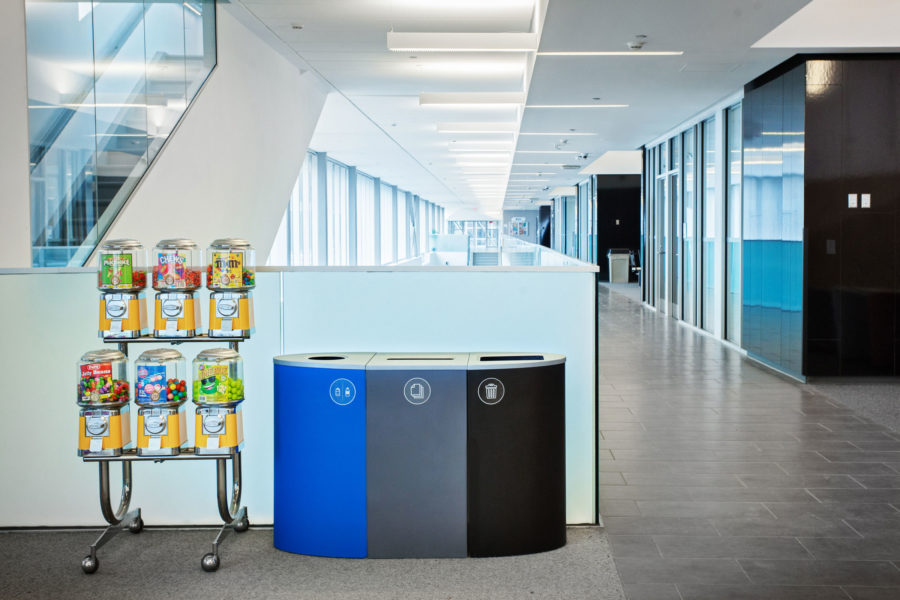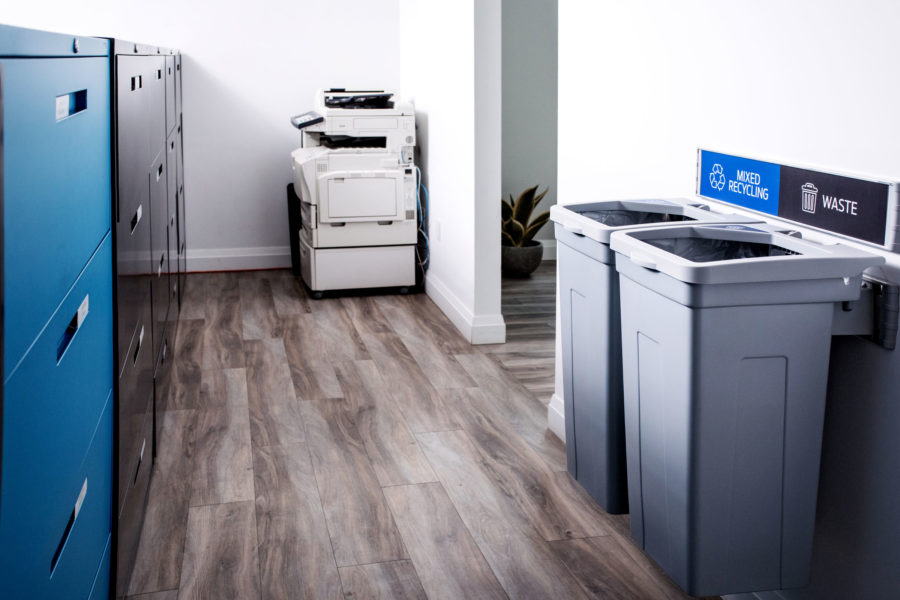Story at a glance:
- Implementing successful recycling systems can directly impact how people care for the spaces they live and visit.
- Best practices like color distinction, proper placement, restrictive lids, and clear signage help direct users where to dispose of items.
- Waste and recycling bins can be subject to fire codes. Busch Systems offers a broad range of fire-rated containers made of metal or plastics with fire-retardant qualities.
Simply having the proper recycling receptacles in a space can set a tone for occupants that says “we care about our health and future.” Recycling systems can be especially important in a school environment where children establish life habits.
Putting recycling receptacles in a space and teaching occupants how to properly use them can directly impact how people care for the spaces they live and visit. “In the same way that beautification and litter cleanup efforts visibly demonstrates a community’s pride and can shape how other people’s perceive it, having a recycling and waste reduction program makes a statement about a school or any organization,” says Alec Cooley, senior advisor at waste and recycling container manufacturer Busch Systems®. “Seeing recycling bins placed next to waste receptacles communicates something about your school or organization’s values—that you are forward-looking. It shows your concern and your compassion. It all helps to set that tone.”
Developers at Busch Systems have been researching and creating recycling and waste management containers that encourage proper recycling since the mid-1980s. Founder Craig Busch got the idea to start the company as a student at York University in Toronto after noticing the need to improve the heavy, difficult-to-use curbside recycling bins implemented in Kitchener, Ontario. The rest is history.
Busch Systems now offers a wide variety of recycling and waste management options to meet the needs of every space—from schools and office buildings to parks and stadiums and beyond.
Healthy Habits

Photo courtesy of Busch Systems
Children in schools are learning more than academics. They are also starting to develop their values as human beings. “Kids learn what’s important from those around them,” Cooley says.
Recycling systems in schools model the behavior to teach children and help create lifelong healthy habits. “When kids see their teachers and friends recycling at school it reinforces a habit that often spills over to their home. It also helps to create a sense of ownership in the community and connects them to outcomes that can lead to a greater appreciation for environmental issues down the road.”
How is Recycling Evolving?

Photo courtesy of Busch Systems
The process of recycling has changed a lot in the past 30 years. Whereas recycling efforts used to focus mostly on aluminum cans and glass bottles, it is much more sophisticated now. Recycling programs are evolving to include food waste/composting and other types of materials. These changes have led to the need for more flexibility in container design.
“Waste reduction programs change over time, so it’s important to have bins that can adapt as needed—to add an additional collection stream, update the acceptable items listed on signs, or have labels facing multiple directions that foot traffic may approach from,” Cooley says. There are situations where it’s important to be able to easily move bins, or just the opposite. Busch Systems offers lightweight and more permanent bins, as well as removable hardware to lock bins in place.
As recycling education increases and we learn more about human behavior, there is a growing appreciation for tools that encourage proper sorting. Best practices like color distinction—black for waste, blue for recycling, and green for composting—convenient placement, restrictive lids, and clear signage can make all the difference in guiding users how to correctly dispose of items.
Aesthetic uniformity in bins across facilities is also becoming more standard practice. “Institutions used to take a more ad hoc approach. “New bins were often purchased without consideration for matching the ones already in place,” Cooley says. “Now there is this whole concept of standardization. It’s the same idea as branding. Applying a uniform set of design guidelines to ensure recycling bins look similar in all locations reduces confusion and looks better aesthetically.”
Making sure people can identify recycling receptacles from a distance increases the likelihood that they will use them properly. Busch Systems’ distinctive color-coded bins and clear signage encourages proper disposal.
Cutting Down on Contamination
Incorrect sorting of materials is a big problem for all recycling programs. “It has an impact both ways. When recyclables go into the trash, we lose the value of those recyclables for our economy and our environment,” Cooley says. When trash items are thrown into the recycling, causing contamination, those materials must be cleared out for the recycling to be sold/used to make other products.
Cleaning out contamination takes labor and energy. Sometimes removing the contamination is not worth the effort, and the whole load is unusable. “The effort to pull out items that don’t belong in recycling increases the cost and can have more of an impact on the environment than if it simply went to the landfill,” he says.
Cutting down on contamination is possible with clearly labeled and colored containers. Busch Systems developers also suggest placing trash and recycling directly side-by-side, so both are equally visible from all angles.
Meeting Fire Codes

Photo courtesy of Busch Systems
Waste bins are also subject to fire codes. Bin composition and location are crucial to the safety of occupants. Though states and municipalities work from the same commonly accepted standardized fire codes, they sometimes modify specific regulations. Generally speaking bins must not be placed in hallways or near fire exits in a manner that can impede the ability of occupants to exit a building. In some situations they may also regulate the capacity and material composition of bins. Busch Systems offers a broad range of waste containers that meet local and state fire codes. These include fire-rated containers made of metal or plastics with fire-retardant qualities.
Because local fire marshals have discretion to allow or disallow certain types of bins in specific settings, Cooley advises consulting with them before investing in a large quantity of recycling or waste containers. “At the end of the day, this is about safety,” Cooley says.

